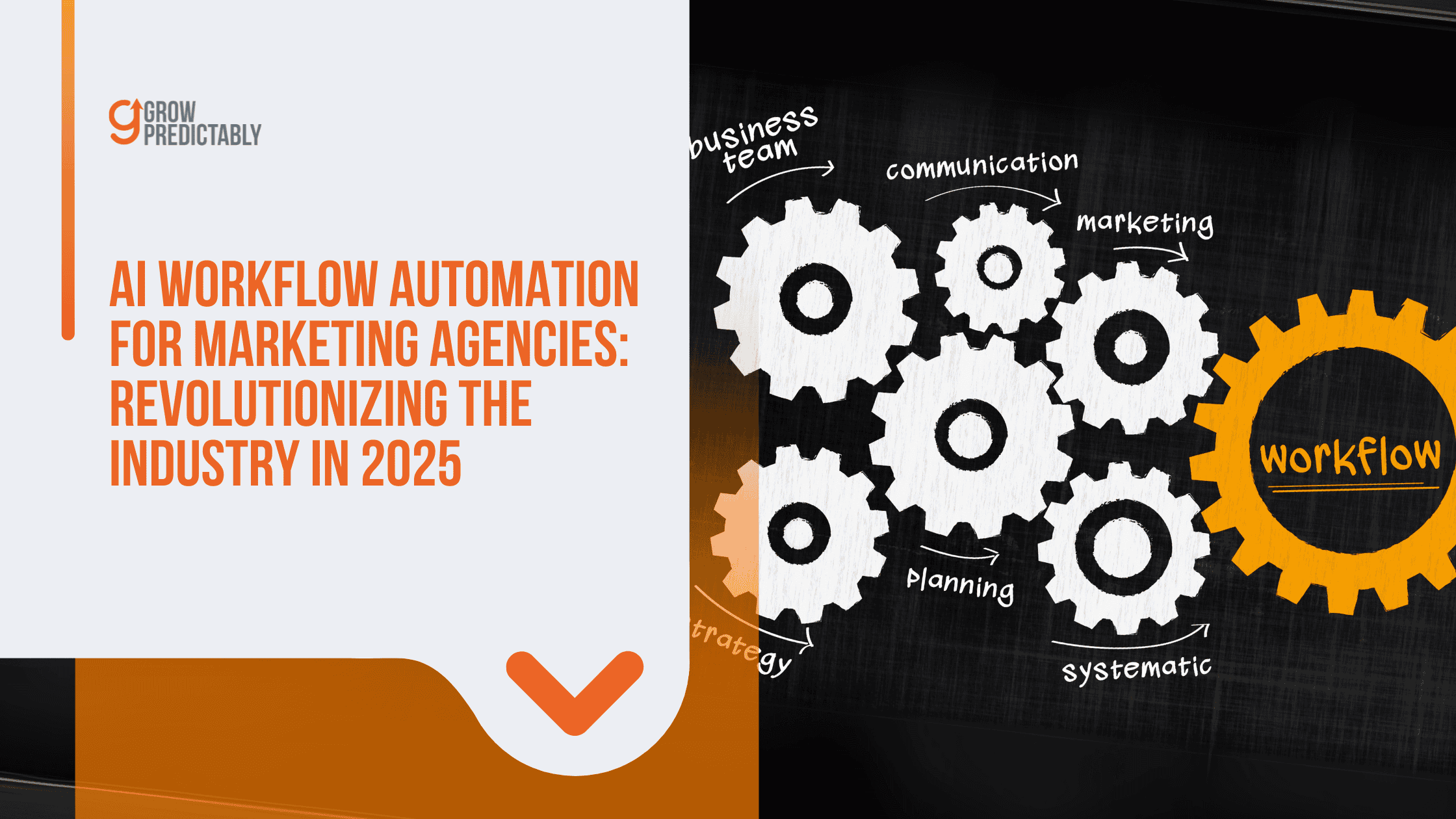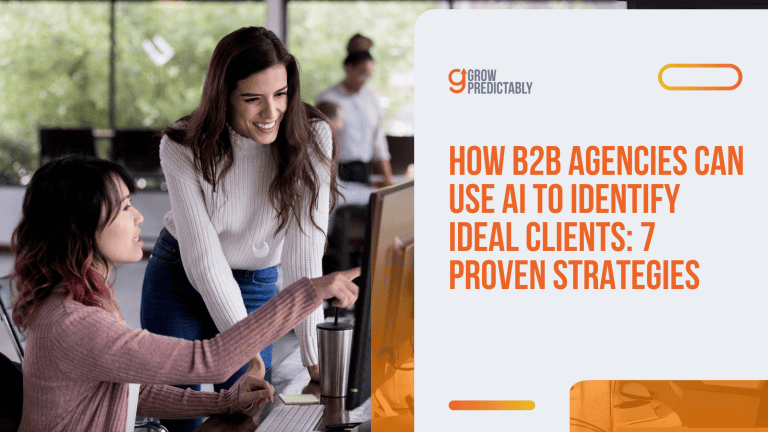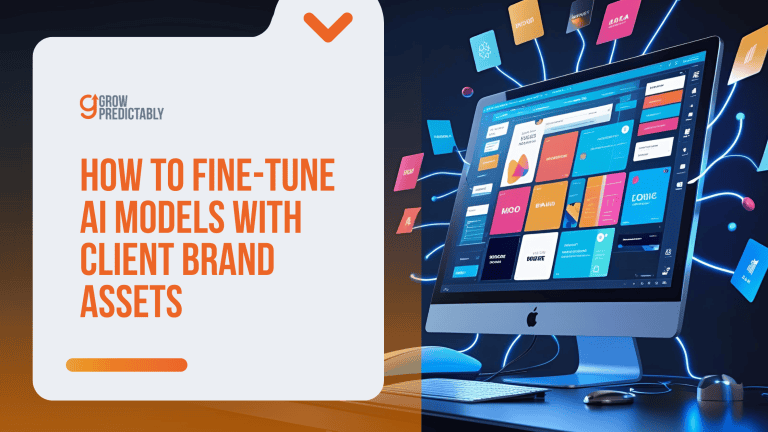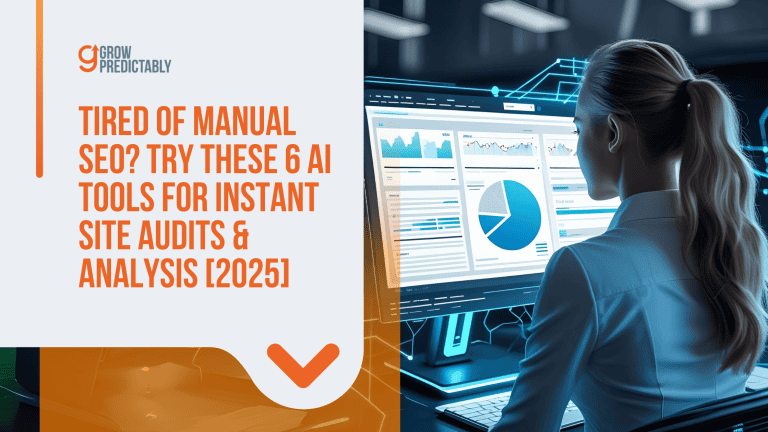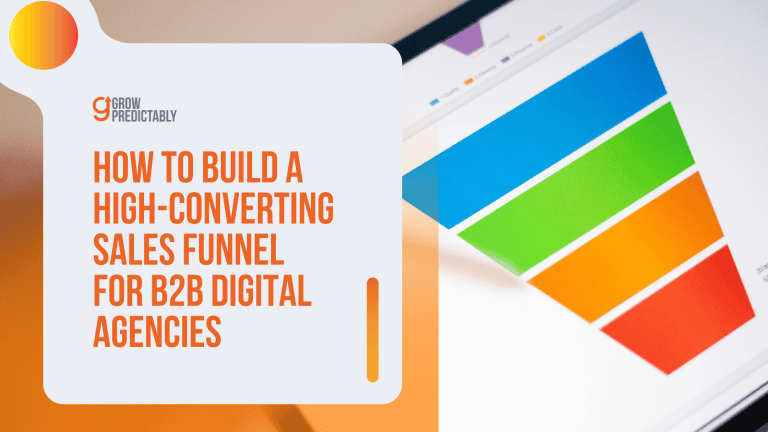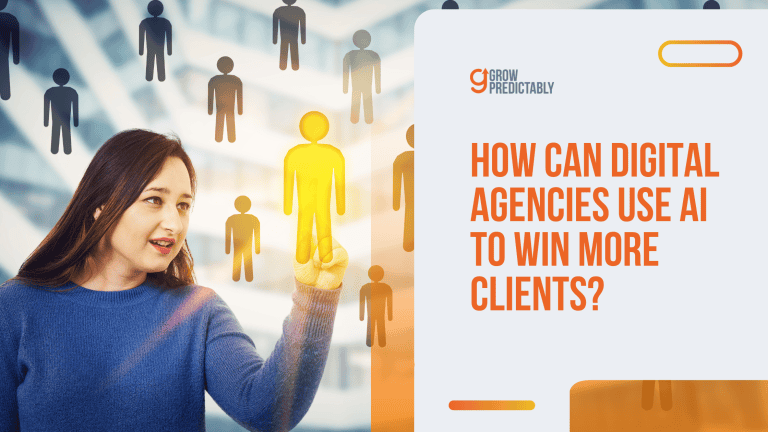AI Workflow Automation for Marketing Agencies: Revolutionizing the Industry in 2025
Imagine running a marketing agency where your team spends 90% of their time on creative strategy and client relationships, while automated systems handle all the tedious tasks that currently eat up your day.
AI workflow automation can cut your administrative workload by up to 70%, allowing your agency to take on more clients without adding staff, deliver faster results with fewer errors, and significantly boost your profit margins.
This directly impacts your agency’s profitability by reducing operational costs and increasing efficiency through automation tools.
The most innovative agencies are now using integrated AI systems, powered by artificial intelligence and AI marketing, that connect their client management, project workflows, content creation, and performance reporting into one seamless ecosystem.
Marketing software serves as the backbone of these AI-driven systems, enabling automation and optimization across all aspects of agency operations.
These systems don’t just save time—they fundamentally transform how agencies operate and scale.
Without this automation, your agency will continue to face the same challenges: burnout from repetitive tasks, narrow profit margins, difficulty scaling, and the constant pressure to do more with less.
Your competitors who embrace these technologies will be able to undercut your prices while delivering faster results.
Don’t let your agency fall behind in the AI revolution.
Read on to discover the specific automation workflows that are transforming marketing agencies from stressed-out service providers into scalable, profitable businesses.
Understand What AI Workflow Automation Means for Marketing Agencies in 2025
Most marketing agencies are working harder instead of smarter.
Your team wastes 60% of their day on tasks that machines could do better.
Meanwhile, your competitors are automating everything and stealing your clients because they deliver faster at lower prices.
AI workflow automation isn’t complicated. It’s software that takes repetitive tasks off your plate. Having a clear ai strategy is essential to ensure successful implementation and maximize the benefits of automation.
It schedules posts, writes email drafts, analyzes campaign data, and adjusts ad spend without you lifting a finger. Automation also streamlines marketing operations, making internal processes more efficient and enabling smoother execution of client campaigns.
Your marketing teams get back hours every day to focus on strategy and creative work that actually moves the needle for clients.

Why 2025 is Different
The rules have changed. Clients expect more for less, and they want it yesterday.
Google’s Search Generative Experience means SEO strategies from last year are already outdated. To meet client expectations, agencies must evolve their marketing strategies by leveraging new tools and technologies.
Meta’s AI tools create and test dozens of ad variations in minutes while your team is still debating headline options.
If you’re not using AI to keep up, you’re already behind. Agencies must also plan their future marketing efforts with AI and automation in mind to remain competitive in a rapidly changing landscape.
Marketing agency owners face three massive problems right now:
- Running campaigns for multiple clients with limited staff
- Creating real-time reports that actually show ROI
- Finding and keeping good people who don’t burn out
Your clients don’t care how you get results—they just want them.
The agencies that deliver faster and more consistently keep their clients longer.
It’s that simple.
The Evolution of Marketing Automation
Basic automation tools from 2020 were just glorified scheduling apps.
Today’s AI systems think for themselves.
Modern AI tools like AutoGPT don’t just follow rules—they make decisions based on real-time data using machine learning and advanced ai algorithms to optimize outcomes.
They learn what works for each client and adjust strategies automatically, leveraging predictive analytics for campaign optimization and forecasting results.
Your AI systems can now optimize campaigns while you sleep.
Here’s what this looks like in your agency:
BEFORE AI:
- Manual campaign setup (2-3 hours)
- Daily performance checks
- Weekly manual reporting
- Human review of every content piece
AFTER AI:
- AI-assisted campaign launch (30 mins)
- Automated performance monitoring
- Real-time dashboard updates
- AI content generation with human oversight
This isn’t just about saving time—it’s about staying in business when your competitors are already making the switch.
The agencies that embrace AI automation now will own the market by 2026.
Everyone else will be playing catch-up or closing shop.
Identify Key Marketing Agency Workflows That Benefit Most from AI Automation
Marketing agencies waste thousands of dollars every month on tasks machines can do better. Automating marketing processes increases efficiency, streamlines workflows, and allows your team to focus on strategic initiatives.
Your team is stuck doing manual work while your competitors are automating everything with advanced marketing tools and at least one automation tool to handle repetitive tasks.
Let’s cut through the BS and focus on exactly where AI makes you the most money.
According to a study by McKinsey, marketing agencies can automate up to 45% of their current workflows using existing AI technology (Source), freeing up your team to focus on high-value work that actually grows your business.

Lead Generation & Nurturing (CVJ: Awareness, Engagement)
Your lead response time directly impacts your conversion rates.
Every minute you delay responding to a hot lead costs you money.
AI systems now handle the entire lead scoring and nurturing process without human intervention. Predictive lead scoring uses AI and machine learning to estimate which prospects are most likely to convert, helping your sales team prioritize leads more effectively.
AI tools analyze prospect behavior across all touchpoints, leveraging customer data to enable more accurate targeting, and automatically trigger personalized follow-ups when someone shows buying intent.
This isn’t just sending generic emails—it’s delivering the right message at the exact moment someone is ready to buy.
- Automated lead scoring based on real-time behavior signals
- Predictive lead scoring to prioritize high-value prospects
- Instant follow-up sequences personalized to each prospect
- 24/7 response to high-intent actions (even at 2 AM)
- Continuous optimization based on what actually converts
Your competitors are using these systems to respond to leads in seconds while your sales team or other sales teams may take hours.
The math is simple: faster response times = more clients = more revenue.
Content Creation & Scheduling (CVJ: Engagement, Subscribe)
Content creation eats up more agency time than almost anything else.
Your writers spend hours staring at blank screens while deadlines loom.
AI tools now handle the heavy lifting so your team can generate marketing content and produce 3x more content with the same headcount.
Smart agencies use AI to create first drafts, adapt marketing content across platforms, and schedule everything for optimal engagement times, including social media posts.
Your human team still adds the strategic and creative elements that machines can’t match.
- Transform one pillar piece into dozens of platform-specific posts, including social media posts
- Generate personalized email sequences for different audience segments
- Optimize headlines and calls-to-action based on performance data
- Schedule content when your specific audience is most active, with social media scheduling as a key feature
Your content team should be focusing on strategy and creative direction—not grinding out social posts and email copy.
AI handles the production work while humans add the magic that actually connects with clients. Content marketing tools are essential for streamlining these processes.
Campaign Management & Optimization (CVJ: Convert, Excite)
Manual campaign management is costing you money every day.
Managing ad campaigns and marketing campaigns across multiple channels is complex and time-consuming, often leading to inefficiencies and missed opportunities.
While your team sleeps, unoptimized campaigns burn through client budgets with little to show for it.
AI campaign tools now monitor campaign performance 24/7 and make real-time adjustments that protect your client’s money.
These systems don’t just collect data—they take action.
They shift budgets from underperforming ads to winners, adjust bids based on conversion likelihood, and even modify creative elements that aren’t resonating.
- Automatic budget reallocation based on real-time performance
- Continuous A/B testing that evolves without manual setup
- Immediate pausing of underperforming ads to prevent wasted spend
- Proactive alerts when campaigns need human attention
Your clients care about results, not how much time you spend tweaking their campaigns.
AI optimization delivers better outcomes with less effort—which means happier clients who stay with you longer by seeing improved results across all their client campaigns.
Reporting & Analytics (CVJ: Advocate)
Your team wastes hours every week pulling data and building reports that clients barely read.
Modern AI reporting tools automatically compile marketing data from all your platforms, streamlining data collection and delivering insights clients actually care about. These tools offer real time analytics, providing valuable insights and data driven insights that help optimize campaign performance.
Instead of spending days on reports, your team can focus on acting on the insights these systems uncover.
The result is more strategic value for clients with less grunt work for your team.
- Automated multi-platform data aggregation and data collection of marketing data
- Custom dashboard creation without manual design work
- Scheduled client reporting that runs without human input
- Insight generation that highlights what matters most
The agencies that deliver clear, actionable insights will always outperform those buried in spreadsheets.
AI reporting gives you back the time to actually implement the strategies your data reveals, supporting data driven decision making for better results.
Internal Ops & Collaboration (CVJ: Ascend, Promote)
Your agency’s internal processes are probably leaking money everywhere.
Projects get stuck, resources sit idle, and deadlines slip because humans are terrible at coordination.
AI project management tools now handle the logistics so your team can focus on execution. These tools enable advanced workflows and automated workflows to streamline operations, optimize project management, and personalize task assignments.
These systems don’t just track tasks—they actively manage workflows.
They route work to the right people, flag bottlenecks before they happen, and ensure nothing falls through the cracks. By implementing automated workflows and advanced workflows, agencies benefit from reducing manual effort in daily operations.
- Intelligent task routing based on team capacity and expertise
- Proactive bottleneck identification and resolution
- Automated resource allocation to maximize productivity
- Real-time project status updates without check-in meetings
Your internal operations directly impact your profit margins.
Agencies that use AI to streamline these processes deliver client work faster with fewer resources—which means more money in your pocket at the end of each month.
Choose the Right AI Workflow Automation Tools for Your Marketing Agency
Most agencies buy too many tools that do the same thing and waste thousands on features they never use.
Stop throwing money at shiny objects.
You need tools that solve real problems and make you more money. When evaluating your options, focus on marketing automation tools, AI marketing software, and marketing platforms that can streamline your workflows and drive results.
I’ve watched agencies blow their entire tech budget on tools that collect dust while the real problems remain unsolved. Consider the types of tools available, including AI powered tools, as they can offer automation, personalization, and efficiency that traditional solutions may lack.
Top AI Tools for Marketing Agencies in 2025
These marketing software tools are battle-tested by agencies that are actually making money, not theoretical BS:
| Tool | Primary Use | Key Features | Pricing (Jan 2025) | Ideal Agency Size |
| Zapier AI | Workflow Integration | Smart task routing, AI automation recipes | Free to start; Pro $29/mo | 1-50 people |
| Jasper AI | Content Creation | Brand voice training, SEO writing | $49/mo start | Any size |
| Improvado | Reporting/Analytics | Data dashboards, live metrics | Custom pricing | 20+ people |
| Akira AI | Campaign Management | Smart budget control, performance triggers | $399/mo start | 10+ people |
| Lately.ai | Social Media | Post generation, voice matching | $99/mo start | 1-20 people |
| Gumloop | Operations | Task routing, workflow triggers | $15/user/mo | Small teams |
| Brandwell | SEO Tools | AI keyword grouping, content suggestions, analyzes and optimizes web pages | $79/mo start | 1-10 people |
Other leading platforms for automation and campaign management include Salesforce Marketing Cloud and Google Ads, which offer advanced features for marketing automation, real-time analytics, and campaign optimization.
Don’t make the rookie mistake of buying every tool at once.
You’ll overwhelm your team and waste money.
Start with one tool that fixes your biggest pain point.
Master it.
Then add another.
Your team will actually use tools they understand.
The difference between agencies that succeed with AI and those that fail isn’t budget—it’s implementation.
Small agencies with disciplined approaches outperform larger agencies with bloated tech stacks every time.
Pick Your Tools Smart
Map Your Needs
Stop buying tools because some guru recommended them.
Look at where your agency is bleeding money and time:
- Write down your biggest time-wasters
- Note which tasks eat up creative energy
- List your must-have integrations
- Identify inefficiencies in client communication
The average agency wastes $12,000 per year on unused software subscriptions. Don’t be average.
Most agencies have no idea what tools they’re actually paying for.
Do a complete audit first—you’ll probably find you’re already paying for solutions you’re not using.
What most agencies miss: The best automation opportunities aren’t always the most obvious ones.
Track where your team spends time for two weeks before making any decisions.
The results will surprise you—it’s rarely where you think.
Match to Your Budget
You don’t need enterprise tools when you’re a small shop.
Start with core functions that directly impact your bottom line:
- Start small with core functions
- Scale up as you see returns
- Remember: cheaper isn’t always better
If a tool doesn’t pay for itself within 60 days by either saving time or making you money, it’s not worth keeping.
Calculate the ROI on every tool: (Hours saved × hourly rate) – monthly cost = true value.
The right tool selection can significantly improve your agency’s profitability by reducing unnecessary costs and increasing efficiency.
If this number isn’t positive, the tool is draining your profits.
The dirty secret of agency tech: More expensive doesn’t mean better results.
Some of the highest-performing agencies run lean stacks with carefully selected tools that do specific jobs exceptionally well.
Don’t fall for enterprise-level pricing when you need focused solutions.
Check Integration Requirements
A tool that doesn’t work with your existing stack or with different systems in your tech stack is useless.
Before buying anything:
- Verify compatibility with your current stack and different systems you use
- Test API connections before buying
- Look for strong support documentation
Nothing kills productivity faster than tools that don’t talk to each other or integrate with different systems.
Make sure everything connects.
The most expensive mistake agencies make is buying tools in isolation without considering how they fit into their overall workflow.
Ask these critical questions:
- Does this tool connect directly to our existing systems and different systems in our tech stack?
- Will we need middleware to make it work?
- What happens when one part of the chain breaks?
Tools that require complex integration setups usually end up abandoned.
Red Flags to Watch For
These warning signs mean a tool will waste your money:
- Poor uptime records
- Weak customer support
- Complicated pricing structures
- Limited integration options
If the company can’t clearly explain their pricing or how their tool works, run away.
You’ll end up paying for features you never use.
Request case studies from agencies similar to yours—if they can’t provide any, that’s a major red flag.
Make sure the tool delivers key benefits relevant to your agency, such as saving time, improving efficiency, supporting growth, leveraging data for smarter decisions, and enhancing personalization and engagement.
The biggest warning sign: Companies that oversell what AI can do.
If they promise their tool will “completely transform your business overnight” or “eliminate the need for humans,” they’re lying.
Real AI tools enhance human capabilities—they don’t replace them.
Your 3-Step Selection Process
Define Your Gaps
Your team knows exactly where the problems are:
- What slows down your team?
- Where do mistakes happen most?
- Which tasks need the most oversight?
- Where do clients drop off in the customer journey?
Ask your people what tasks they hate doing.
Those are your automation targets.
The tasks your team complains about most are usually the ones ripe for automation.
These repetitive, frustrating tasks are exactly what AI excels at handling.
Don’t make assumptions about what needs fixing—get direct input from the people doing the work.
Set up anonymous feedback channels where team members can honestly share their biggest pain points without fear of looking inefficient.
Match Tools to Workflow
Don’t make your workflow fit the tool. Find tools that fix your specific workflow problems:
- Pick tools that fix specific problems
- Make sure they work with your existing setup
- Check they fit your team’s tech comfort level
- Choose tools that enable personalized campaigns, allowing for tailored content delivery and better audience targeting
If your team can’t figure out how to use it in the first hour, they never will.
The best tools feel intuitive from the first use—they don’t require weeks of training or constant reference to documentation.
What separates successful implementation from failure: Getting buy-in from the actual users.
Include your team in demos and trials. If they don’t see the value immediately, neither will your clients.
Let the people who will use the tool daily help make the final decision.
Start Small
The biggest mistake agencies make is trying to change everything at once:
- Test one tool at a time
- Get team feedback early
- Track time savings from day one
Document exactly how much time each tool saves.
This isn’t about having cool tech—it’s about making more money with less effort.
Implement one tool, measure the results for at least 30 days, then decide on the next one. Using automation in this way enables data-driven campaigns, allowing you to optimize efforts based on real-time insights and deliver more targeted results.
This methodical approach prevents change fatigue and gives accurate metrics on each tool’s value.
The hidden benefit of gradual implementation: It builds a culture of continuous improvement rather than disruptive change.
Your team will start looking for optimization opportunities themselves once they see the benefits of thoughtful automation.
The best agencies aren’t the ones with the most tools.
They’re the ones that picked the right tools for their specific problems and actually use them every day.
They understand that technology serves the business—not the other way around.
Every tool should directly contribute to either delivering better client results or improving internal efficiency.
Anything else is a distraction.
Implement AI Workflow Automation: A Step-by-Step Guide for Marketing Agencies
Most agencies fail at automation because they overcomplicate it.
They buy fancy tools, make grand plans, then watch it all crash and burn.
Here’s the brutal truth: simple beats complex every time.
I’m going to show you exactly how to implement AI workflow automation that actually works and will significantly improve your marketing efforts.
1. Map Current Workflows
Most agencies have no idea where their time actually goes.
Your team is wasting hours on tasks that machines could handle in minutes.
Start by tracking exactly what everyone does for two weeks. This process of data collection forms the foundation for mapping your workflow and identifying inefficiencies.
Use time-tracking software or simple spreadsheets.
You’ll be shocked at how much time disappears into administrative black holes.
Run quick audits to find:
- Where leads drop off in your pipeline
- Which approval processes create bottlenecks
- Tasks that drain creative energy from your best people
- Client deliverables that consistently run late
🎯 Quick Win: Don’t try to fix everything at once. Pick the 3 most painful, time-consuming tasks and focus there first. One agency I worked with found their team spent 12 hours every week just formatting client reports—a perfect first target for automation.
What nobody tells you: The biggest time-wasters are usually hidden in the gaps between tasks, not in the tasks themselves.
Look for where work sits idle waiting for approvals or handoffs.
2. Prioritize High-Impact Areas
Not all tasks are worth automating.
Focus on the ones that deliver the biggest returns for the least effort.
The highest-impact automation opportunities usually fall into these categories:
- Weekly reporting that currently takes hours of manual data pulling
- Content scheduling across multiple platforms and clients
- Campaign budget adjustments and performance monitoring
- Repetitive client communications like status updates and check-ins
- Data entry tasks that require moving information between systems
- Marketing tasks that are repetitive and time-consuming, such as email campaigns, social media posting, and lead management
Most agencies waste their automation efforts on tasks that look impressive but don’t actually move the needle.
Ignore the shiny objects.
Focus on the boring, repetitive stuff that eats up your team’s day.
3. Select Tools Based on Goals
Stop buying tools because they have cool features.
Buy tools that solve specific problems.
When evaluating any AI tool, ask these critical questions:
- Does it solve one of our top 3 pain points?
- Will it work with our current tech stack without major modifications?
- Can our team learn it quickly, or will it require extensive training?
- Does the pricing make sense for our agency size and growth stage?
- Does the automation tool address our specific needs for marketing, social media management, email campaigns, or lead generation?
The best tools aren’t necessarily the most advanced ones—they’re the ones your team will actually use.
Complicated tools gather dust while simple ones become part of your daily workflow.
4. Build Smart, Start Small
Trying to overhaul everything at once is a recipe for disaster.
Start with one process, perfect it, then move to the next, incrementally building automated workflows that streamline your operations.
One mid-sized agency started by automating just their client reporting process.
They implemented AI-powered dashboards that pulled data automatically from all their platforms.
This single change freed up 60 hours every month that their team could redirect to strategy and creative work.
What worked: They focused on mastering one system before adding anything else.
They documented the entire process so new team members could learn it quickly.
They measured the time saved religiously to prove the ROI.
5. Invite Feedback While Testing
Your team knows the daily pain points better than anyone.
If they hate using a tool, it doesn’t matter how powerful it is—it will fail.
Make your team active participants in the automation process:
- Run short pilot programs (2-4 weeks) with clear goals
- Create anonymous feedback channels where people can be brutally honest
- Track what works and what causes frustration. Automation can also enhance customer engagement by making it easier to collect and act on feedback, leading to more personalized and effective interactions.
- Make adjustments based on actual usage, not theoretical benefits
The agencies that succeed with automation listen to their people.
The ones that fail force systems on teams that don’t want them.
There’s no automation powerful enough to overcome active resistance from your team.
6. Train for Adoption
Buying a tool isn’t enough—your team needs to know how to use it effectively.
Most automation initiatives fail because of poor training, not poor technology.
Make learning part of your culture:
- Host lunch-and-learn sessions with practical exercises, not boring lectures
- Create short video tutorials (under 5 minutes) for specific tasks
- Celebrate and share wins when someone finds a clever automation hack
- Leverage free training resources from vendors like Akira Academy or Zapier University
- Show team members how to leverage AI-driven insights in their daily work to improve decision-making and personalize marketing efforts
The biggest training mistake: Teaching features instead of workflows.
Don’t show people all the things a tool can do—show them exactly how it solves their specific problems.
7. Monitor + Optimize
What gets measured gets improved.
If you’re not tracking the impact of your automation efforts, you’re flying blind.
Set up simple dashboards to track:
- Time saved per automated task (compare before and after)
- Quality improvements in deliverables
- Team satisfaction scores
- Client results and feedback
- Revenue per employee (this should increase as automation takes hold)
- Campaign performance metrics (monitor and analyze campaign performance to optimize strategies and demonstrate ROI)
🎯 Pro Tip: Review these metrics weekly, not quarterly. Automation should show immediate returns. If it’s not delivering value within the first month, something’s wrong with your implementation.
The agencies crushing it with AI automation aren’t the ones with the biggest budgets or the fanciest tech stacks.
They’re the ones that took a methodical approach, focused on solving real problems, and created systems their teams actually use.
Don’t get distracted by AI hype.
Focus on the fundamentals: identify your biggest time-wasters, find tools that solve those specific problems, implement them one at a time, and track the results religiously.
Everything else is just noise.
Overcome Common Challenges When Adopting AI Workflow Automation [Customer Value Journey]
Adding AI to your marketing agency isn’t always smooth sailing.
You’ll hit bumps at each stage of your Customer Value Journey, especially when it comes to managing and optimizing customer interactions through automation.
Here’s how to handle these problems without wrecking your entire operation.
Awareness Stage → Data Silos & API Challenges
Getting your tools to talk to each other is often the first big headache.
When client info is stuck in different systems, your AI can’t see the whole picture.
Fix this by:
- Picking tools that already connect with your CRM (Gumloop + HubSpot work together out of the box)
- Setting up automatic data sharing from day one
- Testing small data transfers before moving everything over
Engagement Stage → Team Pushback
Your creative people didn’t join your agency to become tech babysitters.
Marketing teams will fight back if they think AI is coming for their jobs.
Win your team over by:
- Showing how AI handles the boring stuff so they can do more creative work
- Starting with one team’s biggest headache and fixing it completely
- Celebrating wins openly when someone saves time using AI
Don’t talk about AI as amazing tech—show exactly how it makes each person’s job better and less stressful.
Focus on what’s in it for them, not how cool the technology is.
Subscribe Stage → Unrealistic Expectations
Many agency owners expect AI to work perfectly right away.
When it doesn’t, they get disappointed and abandon the whole project.
Set better expectations by:
- Creating a 3-month plan with clear milestones
- Starting with simple tasks before tackling harder ones
- Tracking where you started so you can see small improvements
- Focusing on the key benefits of automation, such as saving time, improving efficiency, and supporting growth
Convert Stage → Tech Glitches
Nothing kills momentum like broken automation.
When systems fail during important client work, people lose faith in the entire AI project.
Prevent and handle tech problems by:
- Choosing tools with 99%+ uptime guarantees
- Testing how fast support responds before buying anything
- Keeping manual backup plans for critical work, as some situations may require manual effort to resolve issues when automation fails
Write down every problem and solution you find.
This creates a troubleshooting guide specific to your agency that helps fix future issues faster.
Excite Stage → Over Automation Risk
You can automate too much.
Some client touch points need a human’s judgment and personal touch.
Keep humans involved where it matters by:
- Writing proposals yourself (use AI for research and formatting)
- Having real people run client kickoffs and important meetings
- Setting up human checkpoints to review quality before things go to clients
- Maintaining direct client communication for personalized interactions and relationship building
The goal is to make your team stronger with AI, not replace them.
Ascend Stage → Measuring ROI
Vague claims about “being more efficient” won’t justify what you spent on AI.
You need real numbers that show business impact.
Track meaningful metrics like:
- Money saved per hour of automation (total spent ÷ hours saved)
- How much faster you deliver work (before and after AI)
- Quality ratings from clients (did work get better or worse?)
- How many more clients you can handle without hiring
These metrics directly influence your agency’s profitability by highlighting where automation and efficiency improvements reduce costs and drive sustainable growth.
Make a simple dashboard showing these numbers.
Advocate Stage → Integration Complexity
As you add more AI tools, keeping everything working together gets harder.
Your tech stack can become a tangled mess, especially as you integrate various marketing platforms alongside other tools.
Manage growing complexity by:
- Creating a simple map showing how all your tools and marketing platforms connect
- Appointing one person to oversee your tech ecosystem
- Checking quarterly for tools and marketing platforms you’re paying for but not using
The most successful agencies keep their tech simple and purposeful rather than jumping on every new AI tool that hits the market.
Promote Stage → Security and Client Trust
As your AI handles more sensitive client data and customer data, keeping everything secure becomes crucial.
One data breach can undo all your hard work.
Protect your operation by:
- Limiting who can access different AI systems
- Creating clear rules for handling client and customer data
- Regularly checking for security weak points
Don’t wait for clients to ask about security—bring it up first to show you’re on top of things.
Quick-Check Challenge Guide:
🟢 Easy Fix: Team training, tweaking workflows 🟡 Plan Ahead: Connecting data systems, measuring results 🟤 Get Help: Security issues, changing major systems
Remember: These challenges don’t mean you’re failing—they show you’re moving forward.
Every problem you solve puts distance between you and competitors still doing things the old way.
AI works best when it helps your team shine brighter, not when it tries to run the whole show.
Focus on steady progress instead of getting everything perfect, and you’ll build an AI system that gives your agency a real advantage at every stage of your Customer Value Journey.
By addressing these challenges, you strengthen your overall marketing strategy and ensure your efforts are aligned for long-term success.
FAQs
Your Smartest Hire in 2025 Won’t Be Human
Let’s recap—AI workflow automation delivers results marketing agencies once thought impossible:
💡 Instantly qualified leads, content personalization at scale to reach your target audience and target audiences more effectively, automated performance tweaks, and brilliant reporting without lifting a finger. Automation now enables agencies to optimize the entire customer journey, tracking and improving every interaction from first touch to conversion.
You now have everything you need to start building your agency’s AI-powered backbone.
Still hesitant? That hesitation could cost you time, clients, and talent.
🧠 Take Action Now: Audit your workflows, identify 3 key pressure points, and test one AI tool for 30 days.
Measure improvement. Iterate. Expand.
Want help?
Download the free “AI for Marketers: 30-Day Starter Guide” from Brandwell Labs or explore real-world automation case studies via The Agency Playbook Podcast.
What’s holding you back from giving your team their most valuable asset: time?
AI won’t replace your agency—it will amplify what makes it great. With advanced AI capabilities like computer vision on the rise, the future of marketing will be shaped by those who embrace these innovations.
But only if you choose to lead, not lag.

